List of birds of Ireland

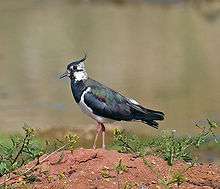
This is a list of the bird species recorded in Ireland. The avifauna of Ireland include a total of 466 species, of which two have been introduced by humans, 255 are rare or accidental and one occurs as both an introduced species and an accidental. Thirteen species are globally threatened. One is extinct.
Ireland has a relatively low diversity of breeding birds due to its isolation. Several species such as the tawny owl, Eurasian nuthatch and willow tit which breed in Great Britain have not been recorded. However, there are large colonies of seabirds including important populations of European storm petrels, northern gannets and roseate terns. Other notable breeding birds include corn crakes and red-billed choughs. There are no endemic species but there are endemic subspecies of white-throated dipper, coal tit and Eurasian jay.
Large numbers of wildfowl and waders winter in Ireland, attracted by its mild climate. About half the world population of Greenland white-fronted geese spend the winter there. During autumn, many migrating seabirds can be seen off the coasts including several species of skuas, shearwaters and petrels. Ireland's westerly position means that North American birds are regularly recorded in autumn.
This list's taxonomic treatment (designation and sequence of orders, families and species) and nomenclature (common and scientific names) largely follow the conventions of The Clements Checklist of Birds of the World, 5th edition although some names more commonly used by Irish birdwatchers are taken from the Irish Rare Birds Committee (IRBC) list. The family accounts at the beginning of each heading reflect the Clements taxonomy, as do the species counts found in each family account. Introduced and accidental species are included in the total counts for Ireland. The total includes three examples of birds that have been accepted onto the official list without being identified to species: frigatebird species, Fea's or Zino's petrel and black or white-tailed wheatear.
The total does not include species placed in Category D of the Irish list. These are species where there is doubt as to whether they have occurred in a wild state (Category D1), they have arrived by human assistance such as on board a ship (D2), they have only been recorded dead on the tideline (D3) or they are feral species whose populations may not be self-sustaining (D4).
The following tags have been used to highlight several categories, but not all species fall into one of these categories. Those that do not, are commonly occurring native species.
- (A) Accidental - a species that rarely or accidentally occurs in Ireland
- (I) Introduced - a species introduced to Ireland as a consequence, direct or indirect, of human actions
- (E) Extirpated - a species which no longer exists in Ireland, but which exists elsewhere
Divers
_in_the_Morro_Bay.jpg)
Order: Gaviiformes Family: Gaviidae
Divers, also known as loons, are a group of aquatic birds found in many parts of North America and northern Europe. They are the size of a large duck or small goose, which they somewhat resemble in shape when swimming, but to which they are completely unrelated.
| Common name | Binomial | Status |
|---|---|---|
| Red-throated diver | Gavia stellata | |
| Black-throated diver | Gavia arctica | (A) |
| Great northern diver | Gavia immer | |
| White-billed diver | Gavia adamsii | (A) |
| Pacific diver | Gavia pacifica | (A) |
Grebes
.jpg)
Order: Podicipediformes Family: Podicipedidae
Grebes are small to medium-large freshwater diving birds. They have lobed toes and are excellent swimmers and divers. However, they have their feet placed far back on the body, making them quite ungainly on land.
| Common name | Binomial | Status |
|---|---|---|
| Little grebe | Tachybaptus ruficollis | |
| Pied-billed grebe | Podilymbus podiceps | (A) |
| Red-necked grebe | Podiceps grisegena | |
| Great crested grebe | Podiceps cristatus | |
| Slavonian grebe | Podiceps auritus | |
| Black-necked grebe | Podiceps nigricollis | (A) |
Albatrosses
Order: Procellariiformes Family: Diomedeidae
The albatrosses are among the largest of flying birds, and the great albatrosses from the genus Diomedea have the largest wingspans of any extant birds.
| Common name | Binomial | Status |
|---|---|---|
| Black-browed albatross | Thalassarche melanophris | (A) |
Shearwaters and petrels

Order: Procellariiformes Family: Procellariidae
The procellariids are the main group of medium-sized "true petrels", characterised by united nostrils with medium septum and a long outer functional primary.
| Common name | Binomial | Status |
|---|---|---|
| Northern fulmar | Fulmarus glacialis | |
| Fea's petrel/Zino's petrel | Pterodroma feae/Pterodroma madeira | (A) |
| Bermuda petrel | Pterodroma cahow | (A) |
| Bulwer's petrel | Bulweria bulwerii | (A) |
| Cory's shearwater | Calonectris borealis | |
| Great shearwater | Ardenna gravis | |
| Sooty shearwater | Ardenna griseus | |
| Manx shearwater | Puffinus puffinus | |
| Balearic shearwater | Puffinus mauretanicus | |
| Macaronesian shearwater | Puffinus baroli | (A) |
Storm petrels
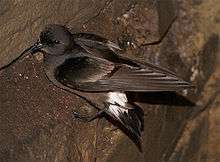
Order: Procellariiformes Family: Hydrobatidae
The storm petrels are relatives of the petrels and are the smallest seabirds. They feed on planktonic crustaceans and small fish picked from the surface, typically while hovering. The flight is fluttering and sometimes bat-like.
| Common name | Binomial | Status |
|---|---|---|
| Wilson's storm petrel | Oceanites oceanicus | (A) |
| European storm petrel | Hydrobates pelagicus | |
| Band-rumped storm petrel | Oceanodroma castro | (A) |
| Leach's storm petrel | Oceanodroma leucorhoa | |
| Swinhoe's storm petrel | Oceanodroma monorhis | (A) |
Boobies and gannets
Order: Suliformes Family: Sulidae
The sulids comprise the gannets and boobies. Both groups are medium to large coastal seabirds that plunge-dive for fish.
| Common name | Binomial | Status |
|---|---|---|
| Northern gannet | Morus bassanus |
Cormorants
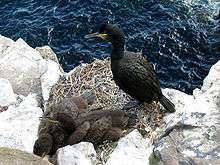
Order: Suliformes Family: Phalacrocoracidae
Phalacrocoracidae is a family of medium to large coastal, fish-eating seabirds that includes cormorants and shags. Plumage colouration varies, with the majority having mainly dark plumage, some species being black-and-white and a few being colourful.
| Common name | Binomial | Status |
|---|---|---|
| Double-crested cormorant | Phalacrocorax auritus | (A) |
| Great cormorant | Phalacrocorax carbo | |
| European shag | Phalacrocorax aristotelis |
Frigatebirds
Order: Suliformes Family: Fregatidae
Frigatebirds are large seabirds usually found over tropical oceans. They are large, black-and-white or completely black, with long wings and deeply forked tails. The males have coloured inflatable throat pouches. They do not swim or walk and cannot take off from a flat surface. Having the largest wingspan-to-body-weight ratio of any bird, they are essentially aerial, able to stay aloft for more than a week.
- Frigatebird sp., probably magnificent frigatebird, Fregata magnificens (A)
Bitterns, herons and egrets
-_In_Breeding_plumage-actively_catching_prey_in_Kolkata_I_IMG_7990.jpg)
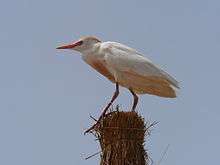
Order: Pelecaniformes Family: Ardeidae
The family Ardeidae contains the bitterns, herons and egrets. Herons and egrets are medium to large wading birds with long necks and legs. Bitterns tend to be shorter necked and more wary. Members of Ardeidae fly with their necks retracted, unlike other long-necked birds such as storks, ibises and spoonbills.
| Common name | Binomial | Status |
|---|---|---|
| Grey heron | Ardea cinerea | |
| Purple heron | Ardea purpurea | (A) |
| Great egret | Ardea alba | (A) |
| Little egret | Egretta garzetta | |
| Squacco heron | Ardeola ralloides | (A) |
| Cattle egret | Bubulcus ibis | (A) |
| Green heron | Butorides virescens | (A) |
| Little blue heron | Egretta caerulea | (A) |
| Black-crowned night heron | Nycticorax nycticorax | (A) |
| American bittern | Botaurus lentiginosus | (A) |
| Great bittern | Botaurus stellaris | (A) |
| Little bittern | Ixobrychus minutus | (A) |
Ibises and spoonbills
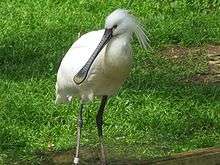
Order: Pelecaniformes Family: Threskiornithidae
Threskiornithidae is a family of large terrestrial and wading birds which includes the ibises and spoonbills. They have long, broad wings with 11 primary and about 20 secondary feathers. They are strong fliers and despite their size and weight, very capable soarers.
| Common name | Binomial | Status |
|---|---|---|
| Glossy ibis | Plegadis falcinellus | (A) |
| Eurasian spoonbill | Platalea leucorodia | (A) |
Storks
Order: Ciconiiformes Family: Ciconiidae
Storks are large, long-legged, long-necked, wading birds with long, stout bills. Storks are mute, but bill-clattering is an important mode of communication at the nest. Their nests can be large and may be reused for many years. Many species are migratory.
| Common name | Binomial | Status |
|---|---|---|
| Black stork | Ciconia nigra | (A) |
| White stork | Ciconia ciconia | (A) |
Ducks, geese and swans


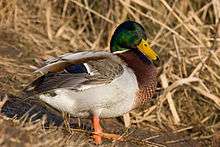

Order: Anseriformes Family: Anatidae
Anatidae includes the ducks and most duck-like waterfowl, such as geese and swans. These birds are adapted to an aquatic existence with webbed feet, flattened bills, and feathers that are excellent at shedding water due to an oily coating.
| Common name | Binomial | Status |
|---|---|---|
| Mute swan | Cygnus olor | |
| Whooper swan | Cygnus cygnus | |
| Bewick's swan | Cygnus columbianus | |
| Bean goose | Anser fabalis | |
| Pink-footed goose | Anser brachyrhynchus | |
| Greater white-fronted goose | Anser albifrons | |
| Lesser white-fronted goose | Anser erythropus | (A) |
| Greylag goose | Anser anser | |
| Snow goose | Chen caerulescens | (A) |
| Brent goose | Branta bernicla | |
| Barnacle goose | Branta leucopsis | |
| Canada goose | Branta canadensis | (A, I) |
| Cackling goose | Branta hutchinsii | (A) |
| Red-breasted goose | Branta ruficollis | (Cat. D1) |
| Ruddy shelduck | Tadorna ferruginea | (A) |
| Common shelduck | Tadorna tadorna | |
| Mandarin duck | Aix galericulata | (I) |
| Eurasian wigeon | Anas penelope | |
| American wigeon | Anas americana | (A) |
| Gadwall | Anas strepera | |
| Baikal teal | Anas formosa | (Cat. D1) |
| Green-winged teal | Anas carolinensis | (A) |
| Common teal | Anas crecca | |
| Falcated teal | Anas falcata | (A) |
| Mallard | Anas platyrhynchos | |
| American black duck | Anas rubripes | (A) |
| Northern pintail | Anas acuta | |
| Garganey | Anas querquedula | |
| Blue-winged teal | Anas discors | (A) |
| Northern shoveler | Anas clypeata | |
| Red-crested pochard | Netta rufina | (A) |
| Common pochard | Aythya ferina | |
| Redhead | Aythya americana | (A) |
| Ring-necked duck | Aythya collaris | (A) |
| Ferruginous duck | Aythya nyroca | (A) |
| Tufted duck | Aythya fuligula | |
| Greater scaup | Aythya marila | |
| Lesser scaup | Aythya affinis | (A) |
| Common eider | Somateria mollissima | |
| King eider | Somateria spectabilis | (A) |
| Long-tailed duck | Clangula hyemalis | |
| Common scoter | Melanitta nigra | |
| Surf scoter | Melanitta perspicillata | (A) |
| Velvet scoter | Melanitta fusca | |
| Common goldeneye | Bucephala clangula | |
| Barrow's goldeneye | Bucephala islandica | (A) |
| Bufflehead | Bucephala albeola | (A) |
| Smew | Mergellus albellus | |
| Hooded merganser | Lophodytes cucullatus | (A) |
| Red-breasted merganser | Mergus serrator | |
| Goosander | Mergus merganser | |
| Ruddy duck | Oxyura jamaicensis | (I) |
Osprey
Order: Accipitriformes Family: Pandionidae
The Pandionidae family contains only one species, the osprey. The osprey is a medium-large raptor which is a specialist fish-eater with a worldwide distribution.
| Common name | Binomial | Status |
|---|---|---|
| Osprey | Pandion haliaetus |
Hawks, kites and eagles
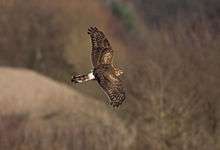
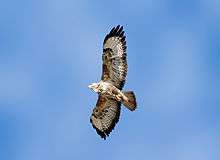
Order: Accipitriformes Family: Accipitridae
Accipitridae is a family of birds of prey, which includes hawks, eagles, kites, harriers and Old World vultures. These birds have powerful hooked beaks for tearing flesh from their prey, strong legs, powerful talons and keen eyesight.
| Common name | Binomial | Status |
|---|---|---|
| European honey buzzard | Pernis apivorus | (A) |
| Red kite | Milvus milvus | |
| Black kite | Milvus migrans | (A) |
| White-tailed eagle | Haliaeetus albicilla | (A, being reintroduced) |
| Bald eagle | Haliaeetus leucocephalus | (A) |
| Eurasian griffon | Gyps fulvus | (A) |
| Western marsh harrier | Circus aeruginosus | |
| Hen harrier | Circus cyaneus | |
| Montagu's harrier | Circus pygargus | (A) |
| Pallid harrier | Circus macrourus | (A) |
| Eurasian sparrowhawk | Accipiter nisus | |
| Northern goshawk | Accipiter gentilis | (A) |
| Eurasian buzzard | Buteo buteo | |
| Rough-legged buzzard | Buteo lagopus | (A) |
| Greater spotted eagle | Clanga clanga | (A) |
| Golden eagle | Aquila chrysaetos | (A, being reintroduced) |
| Booted eagle | Hieraaetus pennatus | (Cat. D1) |
Falcons
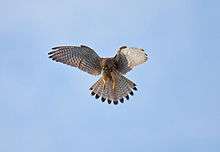
Order: Falconiformes Family: Falconidae
Falconidae is a family of diurnal birds of prey. They differ from hawks, eagles and kites in that they kill with their beaks instead of their talons.
| Common name | Binomial | Status |
|---|---|---|
| Lesser kestrel | Falco naumanni | (A) |
| Eurasian kestrel | Falco tinnunculus | |
| Red-footed falcon | Falco vespertinus | (A) |
| Merlin | Falco columbarius | |
| Eurasian hobby | Falco subbuteo | (A) |
| Gyrfalcon | Falco rusticolus | (A) |
| Peregrine falcon | Falco peregrinus |
Grouse
.jpg)
Order: Galliformes Family: Tetraonidae
Grouse are game birds, similar to quails and partridges.
| Common name | Binomial | Status |
|---|---|---|
| Red grouse | Lagopus lagopus | |
| Eurasian capercaillie | Tetrao urogallus | (E) |
Pheasants and partridges
.jpg)
Order: Galliformes Family: Phasianidae
The Phasianidae are a family of terrestrial birds which consists of quails, partridges, snowcocks, francolins, spurfowls, tragopans, monals, pheasants, peafowls and jungle fowls. In general, they are plump (although they vary in size) and have broad, relatively short wings.
| Common name | Binomial | Status |
|---|---|---|
| Red-legged partridge | Alectoris rufa | (Cat. D4) |
| Grey partridge | Perdix perdix | |
| Common quail | Coturnix coturnix | |
| Ring-necked pheasant | Phasianus colchicus | (I) |
Cranes
Order: Gruiformes Family: Gruidae
Cranes are large, long-legged and long-necked birds. Unlike the similar-looking but unrelated herons, cranes fly with necks outstretched, not pulled back. Most have elaborate and noisy courting displays or "dances".
| Common name | Binomial | Status |
|---|---|---|
| Sandhill crane | Grus canadensis | (A) |
| Common crane | Grus grus | (A) |
Rails, crakes, gallinules and coots
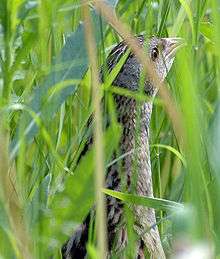
Order: Gruiformes Family: Rallidae
Rallidae is a large family of small to medium-sized birds which includes the rails, crakes, coots and gallinules. Typically they inhabit dense vegetation in damp environments near lakes, swamps or rivers. In general they are shy and secretive birds, making them difficult to observe. Most species have strong legs and long toes which are well adapted to soft uneven surfaces. They tend to have short, rounded wings and to be weak fliers.
| Common name | Binomial | Status |
|---|---|---|
| Water rail | Rallus aquaticus | |
| Corn crake | Crex crex | |
| Little crake | Porzana parva | (A) |
| Baillon's crake | Porzana pusilla | (A) |
| Spotted crake | Porzana porzana | (A) |
| Sora | Porzana carolina | (A) |
| Common moorhen | Gallinula chloropus | |
| Eurasian coot | Fulica atra | |
| American coot | Fulica americana | (A) |
| American purple gallinule | Porphyrio martinicus | (Cat:D3) |
Bustards
Order: Otidiformes Family: Otididae
Bustards are large terrestrial birds mainly associated with dry open country and steppes in the Old World. They are omnivorous and nest on the ground. They walk steadily on strong legs and big toes, pecking for food as they go. They have long broad wings with "fingered" wingtips and striking patterns in flight. Many have interesting mating displays.
| Common name | Binomial | Status |
|---|---|---|
| Great bustard | Otis tarda | (A) |
| Little bustard | Tetrax tetrax | (A) |
Oystercatchers
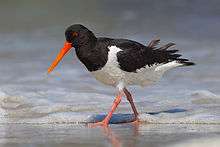
Order: Charadriiformes Family: Haematopodidae
The oystercatchers are large and noisy plover-like birds, with strong bills used for smashing or prising open molluscs.
| Common name | Binomial | Status |
|---|---|---|
| Eurasian oystercatcher | Haematopus ostralegus |
Avocets and stilts
Order: Charadriiformes Family: Recurvirostridae
Recurvirostridae is a family of large wading birds, which includes the avocets and stilts. The avocets have long legs and long up-curved bills. The stilts have extremely long legs and long, thin, straight bills.
| Common name | Binomial | Status |
|---|---|---|
| Black-winged stilt | Himantopus himantopus | (A) |
| Pied avocet | Recurvirostra avosetta | (A) |
Thick-knees
Order: Charadriiformes Family: Burhinidae
The thick-knees are a group of largely tropical waders in the family Burhinidae. They are found worldwide within the tropical zone, with some species also breeding in temperate Europe and Australia. They are medium to large waders with strong black or yellow-black bills, large yellow eyes and cryptic plumage. Despite being classed as waders, most species have a preference for arid or semi-arid habitats.
| Common name | Binomial | Status |
|---|---|---|
| Stone curlew | Burhinus oedicnemus | (A) |
Pratincoles and coursers
Order: Charadriiformes Family: Glareolidae
Glareolidae is a family of wading birds comprising the pratincoles, which have short legs, long pointed wings and long forked tails, and the coursers, which have long legs, short wings and long, pointed bills which curve downwards.
| Common name | Binomial | Status |
|---|---|---|
| Cream-coloured courser | Cursorius cursor | (A) |
| Collared pratincole | Glareola pratincola | (A) |
| Black-winged pratincole | Glareola nordmanni | (A) |
Plovers and lapwings


_(11).jpg)
Order: Charadriiformes Family: Charadriidae
The family Charadriidae includes the plovers, dotterels and lapwings. They are small to medium-sized birds with compact bodies, short, thick necks and long, usually pointed, wings. They are found in open country worldwide, mostly in habitats near water.
| Common name | Binomial | Status |
|---|---|---|
| Northern lapwing | Vanellus vanellus | |
| Sociable lapwing | Vanellus gregarius | (A) |
| Pacific golden plover | Pluvialis fulva | (A) |
| American golden plover | Pluvialis dominica | (A) |
| European golden plover | Pluvialis apricaria | |
| Grey plover | Pluvialis squatarola | |
| Common ringed plover | Charadrius hiaticula | |
| Semipalmated plover | Charadrius semipalmatus | (A) |
| Little ringed plover | Charadrius dubius | (A) |
| Killdeer | Charadrius vociferus | (A) |
| Kentish plover | Charadrius alexandrinus | (A) |
| Eurasian dotterel | Charadrius morinellus | (A) |
Sandpipers and allies
.png)
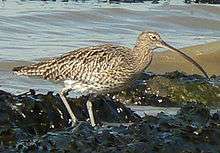
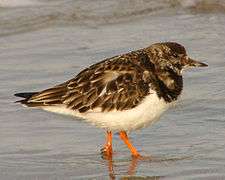
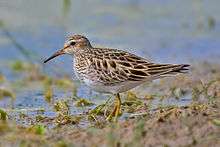
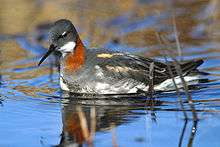
Order: Charadriiformes Family: Scolopacidae
Scolopacidae is a large diverse family of small to medium-sized shorebirds including the sandpipers, curlews, godwits, shanks, tattlers, woodcocks, snipes, dowitchers and phalaropes. The majority of these species eat small invertebrates picked out of the mud or soil. Variation in length of legs and bills enables multiple species to feed in the same habitat, particularly on the coast, without direct competition for food.
| Common name | Binomial | Status |
|---|---|---|
| Eurasian woodcock | Scolopax rusticola | |
| Jack snipe | Lymnocryptes minimus | |
| Great snipe | Gallinago media | (A) |
| Common snipe | Gallinago gallinago | |
| Wilson's snipe | Gallinago delicata | (A) |
| Short-billed dowitcher | Limnodromus griseus | (A) |
| Long-billed dowitcher | Limnodromus scolopaceus | (A) |
| Black-tailed godwit | Limosa limosa | |
| Bar-tailed godwit | Limosa lapponica | |
| Eskimo curlew | Numenius borealis | (A) |
| Whimbrel | Numenius phaeopus | |
| Eurasian curlew | Numenius arquata | |
| Upland sandpiper | Bartramia longicauda | (A) |
| Spotted redshank | Tringa erythropus | |
| Common redshank | Tringa totanus | |
| Marsh sandpiper | Tringa stagnatilis | (A) |
| Common greenshank | Tringa nebularia | |
| Greater yellowlegs | Tringa melanoleuca | (A) |
| Lesser yellowlegs | Tringa flavipes | (A) |
| Green sandpiper | Tringa ochropus | |
| Solitary sandpiper | Tringa solitaria | (A) |
| Wood sandpiper | Tringa glareola | |
| Terek sandpiper | Xenus cinereus | (A) |
| Common sandpiper | Actitis hypoleucos | |
| Spotted sandpiper | Actitis macularia | (A) |
| Ruddy turnstone | Arenaria interpres | |
| Great knot | Calidris tenuirostris | (A) |
| Red knot | Calidris canutus | |
| Sanderling | Calidris alba | |
| Semipalmated sandpiper | Calidris pusilla | (A) |
| Western sandpiper | Calidris mauri | (A) |
| Red-necked stint | Calidris ruficollis | (A) |
| Little stint | Calidris minuta | |
| Temminck's stint | Calidris temminckii | (A) |
| Long-toed stint | Calidris subminuta | (A) |
| Least sandpiper | Calidris minutilla | (A) |
| White-rumped sandpiper | Calidris fuscicollis | (A) |
| Baird's sandpiper | Calidris bairdii | (A) |
| Pectoral sandpiper | Calidris melanotos | |
| Sharp-tailed sandpiper | Calidris acuminata | (A) |
| Curlew sandpiper | Calidris ferruginea | |
| Dunlin | Calidris alpina | |
| Purple sandpiper | Calidris maritima | |
| Stilt sandpiper | Calidris himantopus | (A) |
| Broad-billed sandpiper | Limicola falcinellus | (A) |
| Buff-breasted sandpiper | Tryngites subruficollis | (A) |
| Ruff | Philomachus pugnax | |
| Wilson's phalarope | Phalaropus tricolor | (A) |
| Red-necked phalarope | Phalaropus lobatus | (A, formerly bred) |
| Grey phalarope | Phalaropus fulicarius |
Skuas
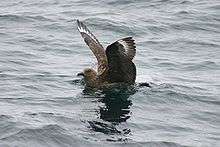
Order: Charadriiformes Family: Stercorariidae
The family Stercorariidae are, in general, medium to large birds, typically with grey or brown plumage, often with white markings on the wings. They nest on the ground in temperate and arctic regions and are long-distance migrants.
| Common name | Binomial | Status |
|---|---|---|
| Great skua | Stercorarius skua | |
| Pomarine skua | Stercorarius pomarinus | |
| Arctic skua | Stercorarius parasiticus | |
| Long-tailed skua | Stercorarius longicaudus |
Gulls

Order: Charadriiformes Family: Laridae
Laridae is a family of medium to large seabirds, the gulls and kittiwakes. They are typically grey or white, often with black markings on the head or wings. They have stout, longish bills and webbed feet.
| Common name | Binomial | Status |
|---|---|---|
| Common gull | Larus canus | |
| Ring-billed gull | Larus delawarensis | |
| Great black-backed gull | Larus marinus | |
| Glaucous gull | Larus hyperboreus | |
| Iceland gull | Larus glaucoides | |
| Thayer's gull | Larus thayeri | (A) |
| Herring gull | Larus argentatus | |
| Lesser black-backed gull | Larus fuscus | |
| Yellow-legged gull | Larus michahellis | |
| American herring gull | Larus smithsonianus | (A) |
| Caspian gull | Larus cachinnans | (A) |
| Slaty-backed gull | Larus schistisagus | (A) |
| Black-headed gull | Chroicocephalus ridibundus | |
| Bonaparte's gull | Chroicocephalus philadelphia | (A) |
| Mediterranean gull | Ichthyaetus melanocephalus | |
| Laughing gull | Leucophaeus atricilla | (A) |
| Franklin's gull | Leucophaeus pipixcan | (A) |
| Little gull | Hydrocoloeus minutus | |
| Ivory gull | Pagophila eburnea | (A) |
| Ross's gull | Rhodostethia rosea | (A) |
| Sabine's gull | Xema sabini | |
| Black-legged kittiwake | Rissa tridactyla |
Terns

Order: Charadriiformes Family: Sternidae
Terns are a group of generally medium to large seabirds typically with grey or white plumage, often with black markings on the head. Most terns hunt fish by diving but some pick insects off the surface of fresh water. Terns are generally long-lived birds, with several species known to live in excess of 30 years.
| Common name | Binomial | Status |
|---|---|---|
| Gull-billed tern | Gelochelidon nilotica | (A) |
| Caspian tern | Hydroprogne caspia | (A) |
| Elegant tern | Thalasseus elegans | (A) |
| Lesser crested tern | Thalasseus bengalensis | (A) |
| Sandwich tern | Thalasseus sandvicensis | |
| Royal tern | Thalasseus maximus | (Cat. D3) |
| Roseate tern | Sterna dougallii | |
| Common tern | Sterna hirundo | |
| Arctic tern | Sterna paradisaea | |
| Forster's tern | Sterna forsteri | (A) |
| Little tern | Sternula albifrons | |
| Bridled tern | Onychoprion anaethetus | (Cat. D3) |
| Sooty tern | Onychoprion fuscatus | (A) |
| Whiskered tern | Chlidonias hybridus | (A) |
| White-winged tern | Chlidonias leucopterus | (A) |
| Black tern | Chlidonias niger |
Auks
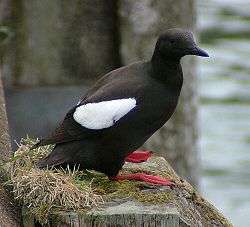
Order: Charadriiformes Family: Alcidae
Alcids are superficially similar to penguins due to their black-and-white colours, their upright posture and some of their habits. However, they are not related to the penguins and differ in being able to fly. Auks live on the open sea, only deliberately coming ashore to nest.
| Common name | Binomial | Status |
|---|---|---|
| Little auk | Alle alle | (A) |
| Guillemot | Uria aalge | |
| Brunnich's guillemot | Uria lomvia | (A) |
| Razorbill | Alca torda | |
| Great auk | Pinguinus impennis | (Extinct) |
| Black guillemot | Cepphus grylle | |
| Atlantic puffin | Fratercula arctica |
Sandgrouse
Order: Pterocliformes Family: Pteroclidae
Sandgrouse have small, pigeon like heads and necks, but sturdy compact bodies. They have long pointed wings and sometimes tails and a fast direct flight. Flocks fly to watering holes at dawn and dusk. Their legs are feathered down to the toes.
| Common name | Binomial | Status |
|---|---|---|
| Pallas's sandgrouse | Syrrhaptes paradoxus | (A) |
Pigeons and doves

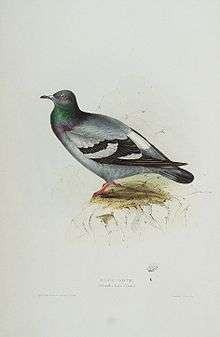
Order: Columbiformes Family: Columbidae
Pigeons and doves are stout-bodied birds with short necks and short slender bills with a fleshy cere.
| Common name | Binomial | Status |
|---|---|---|
| Rock pigeon | Columba livia | |
| Stock dove | Columba oenas | |
| Common wood pigeon | Columba palumbus | |
| European turtle dove | Streptopelia turtur | |
| Eurasian collared dove | Streptopelia decaocto | |
| Mourning dove | Zeanaida macroura | (A) |
Cuckoos
_by_Tim_Peukert.jpg)
Order: Cuculiformes Family: Cuculidae
The family Cuculidae includes cuckoos, roadrunners and anis. These birds are of variable size with slender bodies, long tails and strong legs. The Old World cuckoos are brood parasites.
| Common name | Binomial | Status |
|---|---|---|
| Great spotted cuckoo | Clamator glandarius | (A) |
| Common cuckoo | Cuculus canorus | |
| Black-billed cuckoo | Coccyzus erythropthalmus | (A) |
| Yellow-billed cuckoo | Coccyzus americanus | (A) |
Barn owls
Order: Strigiformes Family: Tytonidae
Barn owls are medium to large owls with large heads and characteristic heart-shaped faces. They have long strong legs with powerful talons.
| Common name | Binomial | Status |
|---|---|---|
| Barn owl | Tyto alba |
Typical owls
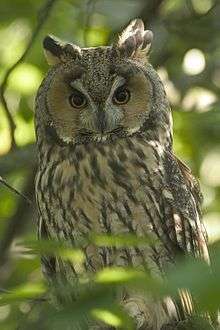
Order: Strigiformes Family: Strigidae
The typical owls are small to large solitary nocturnal birds of prey. They have large forward-facing eyes and ears, a hawk-like beak and a conspicuous circle of feathers around each eye called a facial disk.
| Common name | Binomial | Status |
|---|---|---|
| European scops owl | Otus scops | (A) |
| Snowy owl | Bubo scandiacus | (A) |
| Little owl | Athene noctua | (A) |
| Long-eared owl | Asio otus | |
| Short-eared owl | Asio flammeus | |
| Tawny owl | Strix aluco | (D) |
Nightjars
Order: Caprimulgiformes Family: Caprimulgidae
Nightjars are medium-sized nocturnal birds that usually nest on the ground. They have long wings, short legs and very short bills. Most have small feet, of little use for walking, and long pointed wings. Their soft plumage is camouflaged to resemble bark or leaves.
| Common name | Binomial | Status |
|---|---|---|
| Common nighthawk | Chordeiles minor | (A) |
| Eurasian nightjar | Caprimulgus europaeus |
Swifts
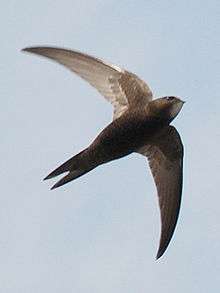
Order: Apodiformes Family: Apodidae
Swifts are small birds which spend the majority of their lives flying. These birds have very short legs and never settle voluntarily on the ground, perching instead only on vertical surfaces. Many swifts have long swept-back wings which resemble a crescent or boomerang.
| Common name | Binomial | Status |
|---|---|---|
| White-throated needletail | Hirundapus caudacutus | (A) |
| Chimney swift | Chaetura pelagica | (A) |
| Alpine swift | Tachymarptis melba | (A) |
| Common swift | Apus apus | |
| Pallid swift | Apus pallidus | (A) |
| Little swift | Apus affinis | (A) |
Kingfishers
.jpg)
Order: Coraciiformes Family: Alcedinidae
Kingfishers are medium-sized birds with large heads, long, pointed bills, short legs and stubby tails.
| Common name | Binomial | Status |
|---|---|---|
| Common kingfisher | Alcedo atthis | |
| Belted kingfisher | Ceryle alcyon | (A) |
Bee-eaters
Order: Coraciiformes Family: Meropidae
The bee-eaters are a group of near passerine birds in the family Meropidae. Most species are found in Africa but others occur in southern Europe, Madagascar, Australia and New Guinea. They are characterised by richly coloured plumage, slender bodies and usually elongated central tail feathers. All are colourful and have long downturned bills and pointed wings, which give them a swallow-like appearance when seen from afar.
| Common name | Binomial | Status |
|---|---|---|
| European bee-eater | Merops apiaster | (A) |
Typical rollers
Order: Coraciiformes Family: Coraciidae
Rollers resemble crows in size and build, but are more closely related to the kingfishers and bee-eaters. They share the colourful appearance of those groups with blues and browns predominating. The two inner front toes are connected, but the outer toe is not.
| Common name | Binomial | Status |
|---|---|---|
| European roller | Coracias garrulus | (A) |
Hoopoes
Order: Coraciiformes Family: Upupidae
Hoopoes have black, white and orangey-pink colouring with a large erectile crest on their head.
| Common name | Binomial | Status |
|---|---|---|
| Hoopoe | Upupa epops |
Woodpeckers and allies

Order: Piciformes Family: Picidae
Woodpeckers are small to medium-sized birds with chisel-like beaks, short legs, stiff tails and long tongues used for capturing insects. Some species have feet with two toes pointing forward and two backward, while several species have only three toes. Many woodpeckers have the habit of tapping noisily on tree trunks with their beaks.
| Common name | Binomial | Status |
|---|---|---|
| Eurasian wryneck | Jynx torquilla | (A) |
| Yellow-bellied sapsucker | Sphyrapicus varius | (A) |
| Great spotted woodpecker | Dendrocopos major | |
| Northern flicker | Colaptes auratus | (Cat.D2) |
| European green woodpecker | Picus viridis | (A) |
Tyrant flycatchers
Order: Passeriformes Family: Tyrannidae
| Common name | Binomial | Status |
|---|---|---|
| Eastern kingbird | Tyrannus tyrannus | (A) |
Larks

Order: Passeriformes Family: Alaudidae
Larks are small terrestrial birds with often extravagant songs and display flights. Most larks are fairly dull in appearance. Their food is insects and seeds.
| Common name | Binomial | Status |
|---|---|---|
| Greater short-toed lark | Calandrella brachydactyla | (A) |
| Wood lark | Lullula arborea | (A) |
| Eurasian skylark | Alauda arvensis | |
| Shore lark | Eremophila alpestris | (A) |
Swallows and martins

Order: Passeriformes Family: Hirundinidae
The family Hirundinidae is adapted to aerial feeding. They have a slender streamlined body, long pointed wings and a short bill with a wide gape. The feet are adapted to perching rather than walking, and the front toes are partially joined at the base.
| Common name | Binomial | Status |
|---|---|---|
| Purple martin | Progne subis | (Cat. D1) |
| Sand martin | Riparia riparia | |
| American cliff swallow | Petrochelidon pyrrhonota | (A) |
| Barn swallow | Hirundo rustica | |
| Red-rumped swallow | Cecropis daurica | (A) |
| Common house martin | Delichon urbicum |
Wagtails and pipits
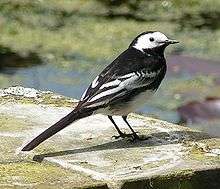
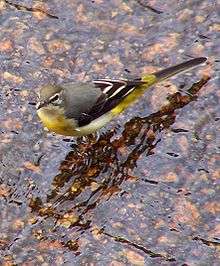
Order: Passeriformes Family: Motacillidae
Motacillidae is a family of small passerine birds with medium to long tails. They include the wagtails, longclaws and pipits. They are slender, ground feeding insectivores of open country.
| Common name | Binomial | Status |
|---|---|---|
| Pied wagtail | Motacilla alba | |
| Citrine wagtail | Motacilla citreola | (A) |
| Western yellow wagtail | Motacilla flava | |
| Grey wagtail | Motacilla cinerea | |
| Richard's pipit | Anthus richardi | (A) |
| Tawny pipit | Anthus campestris | (A) |
| Tree pipit | Anthus trivialis | |
| Olive-backed pipit | Anthus hodgsoni | (A) |
| Pechora pipit | Anthus gustavi | (A) |
| Meadow pipit | Anthus pratensis | |
| Red-throated pipit | Anthus cervinus | (A) |
| Rock pipit | Anthus petrosus | |
| Water pipit | Anthus spinoletta | (A) |
| Buff-bellied pipit | Anthus rubescens | (A) |
Kinglets
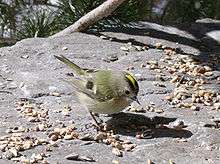
Order: Passeriformes Family: Regulidae
The kinglets, also called crests, are a small group of birds often included in the Old World warblers, but frequently given family status because they also resemble the titmice.
| Common name | Binomial | Status |
|---|---|---|
| Goldcrest | Regulus regulus | |
| Common firecrest | Regulus ignicapillus | |
| Ruby-crowned kinglet | Regulus calendula | (A) |
Waxwings
Order: Passeriformes Family: Bombycillidae
The waxwings are a group of birds with soft silky plumage and unique red tips to some of the wing feathers. In the Bohemian and cedar waxwings, these tips look like sealing wax and give the group its name. These are arboreal birds of northern forests. They live on insects in summer and berries in winter.
| Common name | Binomial | Status |
|---|---|---|
| Bohemian waxwing | Bombycilla garrulus | |
| Cedar waxwing | Bombycilla cedrorum | (A) |
Dippers
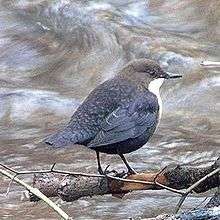
Order: Passeriformes Family: Cinclidae
Dippers are a group of perching birds whose habitat includes aquatic environments in the Americas, Europe and Asia. They are named for their bobbing or dipping movements.
| Common name | Binomial | Status |
|---|---|---|
| White-throated dipper | Cinclus cinclus |
Wrens
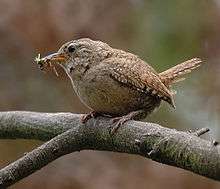
Order: Passeriformes Family: Troglodytidae
The wrens are mainly small and inconspicuous except for their loud songs. These birds have short wings and thin down-turned bills. Several species often hold their tails upright. All are insectivorous.
| Common name | Binomial | Status |
|---|---|---|
| Eurasian wren | Troglodytes troglodytes |
Mockingbirds and thrashers
Order: Passeriformes Family: Mimidae
The mimids are a family of passerine birds that includes thrashers, mockingbirds, tremblers and the New World catbirds. These birds are notable for their vocalizations, especially their ability to mimic a wide variety of birds and other sounds heard outdoors. Their colouring tends towards dull-greys and browns.
| Common name | Binomial | Status |
|---|---|---|
| Grey catbird | Dumetella carolinensis | (A) |
Accentors
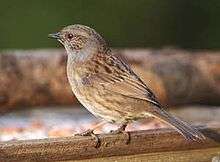
Order: Passeriformes Family: Prunellidae
The accentors are in the only bird family, Prunellidae, which is completely endemic to the Palearctic. They are small, fairly drab species superficially similar to sparrows.
| Common name | Binomial | Status |
|---|---|---|
| Dunnock | Prunella modularis |
Thrushes and allies

Order: Passeriformes Family: Turdidae
The thrushes are a group of passerine birds that occur mainly in the Old World. They are plump, soft plumaged, small to medium-sized insectivores or sometimes omnivores, often feeding on the ground. Many have attractive songs.
| Common name | Binomial | Status |
|---|---|---|
| Siberian thrush | Geokichla sibirica | (A) |
| White's thrush | Zoothera dauma | (A) |
| Grey-cheeked thrush | Catharus minimus | (A) |
| Swainson's thrush | Catharus ustulatus | (A) |
| Hermit thrush | Catharus guttatus | (A) |
| Ring ouzel | Turdus torquatus | |
| Eurasian blackbird | Turdus merula | |
| Fieldfare | Turdus pilaris | |
| Redwing | Turdus iliacus | |
| Song thrush | Turdus philomelos | |
| Mistle thrush | Turdus viscivorus | |
| American robin | Turdus migratorius | (A) |
Cisticolas and allies
Order: Passeriformes Family: Cisticolidae
The Cisticolidae are warblers found mainly in warmer southern regions of the Old World. They are generally very small birds of drab brown or grey appearance found in open country such as grassland or scrub.
| Common name | Binomial | Status |
|---|---|---|
| Zitting cisticola | Cisticola juncidis | (A) |
Cettid warblers
Order: Passeriformes Family: Cettiidae
| Common name | Binomial | Status |
|---|---|---|
| Cetti's warbler | Cettia cetti | (A) |
Locustellid warblers
Order: Passeriformes Family: Locustellidae
| Common name | Binomial | Status |
|---|---|---|
| Common grasshopper warbler | Locustella naevia | |
| Pallas's grasshopper warbler | Locustella certhiola | (A) |
| Savi's warbler | Locustella luscinioides | (A) |
Acrocephalidid warblers
Order: Passeriformes Family: Acrocephalidae
| Common name | Binomial | Status |
|---|---|---|
| Aquatic warbler | Acrocephalus paludicola | (A) |
| Sedge warbler | Acrocephalus schoenobaenus | |
| Paddyfield warbler | Acrocephalus agricola | (A) |
| Blyth's reed warbler | Acrocephalus dumetorum | (A) |
| Eurasian reed warbler | Acrocephalus scirpaceus | |
| Marsh warbler | Acrocephalus palustris | (A) |
| Great reed warbler | Acrocephalus arundinaceus | (A) |
| Booted warbler | Iduna caligata | (A) |
| Sykes's warbler | Iduna rama | (A) |
| Eastern olivaceous warbler | Iduna pallida | (A) |
| Melodious warbler | Hippolais polyglotta | (A) |
| Icterine warbler | Hippolais icterina | (A) |
Phylloscopid warblers
Order: Passeriformes Family: Phylloscopidae
| Common name | Binomial | Status |
|---|---|---|
| Willow warbler | Phylloscopus trochilus | |
| Common chiffchaff | Phylloscopus collybita | |
| Western Bonelli's warbler | Phylloscopus bonelli | (A) |
| Wood warbler | Phylloscopus sibilatrix | |
| Dusky warbler | Phylloscopus fuscatus | (A) |
| Radde's warbler | Phylloscopus schwarzi | (A) |
| Pallas's leaf warbler | Phylloscopus proregulus | (A) |
| Yellow-browed warbler | Phylloscopus inornatus | |
| Hume's leaf warbler | Phylloscopus humei | (A) |
| Arctic warbler | Phylloscopus borealis | (A) |
| Greenish warbler | Phylloscopus trochiloides | (A) |
Old World warblers
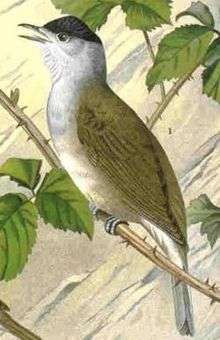
Order: Passeriformes Family: Sylviidae
The family Sylviidae is a group of small insectivorous passerine birds. They mainly occur as breeding species, as the common name implies, in Europe, Asia and, to a lesser extent, Africa. Most are of generally undistinguished appearance, but many have distinctive songs.
| Common name | Binomial | Status |
|---|---|---|
| Eurasian blackcap | Sylvia atricapilla | |
| Garden warbler | Sylvia borin | |
| Greater whitethroat | Sylvia communis | |
| Lesser whitethroat | Sylvia curruca | |
| Barred warbler | Sylvia nisoria | (A) |
| Subalpine warbler | Sylvia cantillans | (A) |
| Sardinian warbler | Sylvia melanocephala | (A) |
| Dartford warbler | Sylvia undata | (A) |
Old World flycatchers and chats
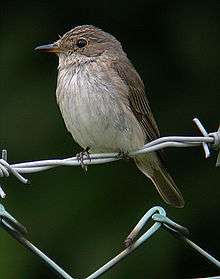
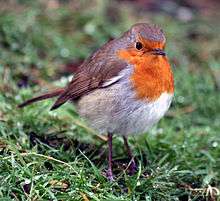
Order: Passeriformes Family: Muscicapidae
Old World flycatchers and chats are a large group of small passerine birds native to the Old World. They are mainly small arboreal insectivores. The appearance of these birds is highly varied, but they mostly have weak songs and harsh calls.
| Common name | Binomial | Status |
|---|---|---|
| Common rock thrush | Monticola saxatilis | (A) |
| Spotted flycatcher | Muscicapa striata | |
| Pied flycatcher | Ficedula hypoleuca | |
| Collared flycatcher | Ficedula albicollis | (A) |
| Red-breasted flycatcher | Ficedula parva | (A) |
| European robin | Erithacus rubecula | |
| Thrush nightingale | Luscinia luscinia | (A) |
| Common nightingale | Luscinia megarhynchos | (A) |
| Bluethroat | Luscinia svecica | (A) |
| Rufous-tailed scrub robin | Cercotrichas galactotes | (A) |
| Red-flanked bluetail | Tarsiger cyanurus | (A) |
| Black redstart | Phoenicurus ochruros | |
| Common redstart | Phoenicurus phoenicurus | |
| Whinchat | Saxicola rubetra | |
| European stonechat | Saxicola rubicola | |
| Black wheatear/White-tailed wheatear | Oenanthe leucura/Oenanthe leucopyga | (A) |
| Northern wheatear | Oenanthe oenanthe | |
| Pied wheatear | Oenanthe pleschanka | (A) |
| Black-eared wheatear | Oenanthe hispanica | (A) |
| Desert wheatear | Oenanthe deserti | (A) |
| Isabelline wheatear | Oenanthe isabellina | (A) |
Bearded reedling
Order: Passeriformes Family: Panuridae
| Common name | Binomial | Status |
|---|---|---|
| Bearded reedling | Panurus biarmicus | (A) |
Long-tailed tits
.jpg)
Order: Passeriformes Family: Aegithalidae
Long-tailed tits are a group of small passerine birds with medium to long tails. They make woven bag nests in trees. Most eat a mixed diet which includes insects. There are about 9 species worldwide and 1 species which occurs in Ireland.
| Common name | Binomial | Status |
|---|---|---|
| Long-tailed tit | Aegithalos caudatus |
Tits
_on_line.jpeg)
Order: Passeriformes Family: Paridae
The Paridae are mainly small stocky woodland species with short stout bills. Some have crests. They are adaptable birds, with a mixed diet including seeds and insects.
| Common name | Binomial | Status |
|---|---|---|
| Marsh tit | Poecile palustris | (A) |
| Coal tit | Periparus ater | |
| Great tit | Parus major | |
| Eurasian blue tit | Cyanistes caeruleus |
Treecreepers

Order: Passeriformes Family: Certhiidae
Treecreepers are small woodland birds, brown above and white below. They have thin pointed down-curved bills, which they use to extricate insects from bark. They have stiff tail feathers, like woodpeckers, which they use to support themselves on vertical trees.
| Common name | Binomial | Status |
|---|---|---|
| Eurasian treecreeper | Certhia familiaris |
Old World orioles
Order: Passeriformes Family: Oriolidae
The Old World orioles are colourful passerine birds. They are not related to the New World orioles.
| Common name | Binomial | Status |
|---|---|---|
| Eurasian golden oriole | Oriolus oriolus | (A) |
Shrikes

Order: Passeriformes Family: Laniidae
Shrikes are passerine birds known for their habit of catching other birds and small animals and impaling the uneaten portions of their bodies on thorns. A typical shrike's beak is hooked, like a bird of prey.
| Common name | Binomial | Status |
|---|---|---|
| Red-backed shrike | Lanius collurio | |
| Isabelline shrike | Lanius isabellinus | (A) |
| Brown shrike | Lanius cristatus | (A) |
| Northern shrike | Lanius excubitor | |
| Lesser grey shrike | Lanius minor | (A) |
| Woodchat shrike | Lanius senator | (A) |
Crows, jays, ravens and magpies

Order: Passeriformes Family: Corvidae
The family Corvidae includes crows, ravens, jackdaws, jays, choughs, magpies, treepies, nutcrackers and ground jays. Corvids are above average in size among the Passeriformes, and some of the larger species show high levels of intelligence.
| Common name | Binomial | Status |
|---|---|---|
| Eurasian jay | Garrulus glandarius | |
| Eurasian magpie | Pica pica | |
| Red-billed chough | Pyrrhocorax pyrrhocorax | |
| Eurasian jackdaw | Corvus monedula | |
| House crow | Corvus splendens | (Cat.D2) |
| Rook | Corvus frugilegus | |
| Carrion crow | Corvus corone | |
| Common raven | Corvus corax | |
| Hooded crow | Corvus cornix |
Starlings

Order: Passeriformes Family: Sturnidae
Starlings are small to medium-sized passerine birds. Their flight is strong and direct and they are very gregarious. Their preferred habitat is fairly open country. They eat insects and fruit. Plumage is typically dark with a metallic sheen.
| Common name | Binomial | Status |
|---|---|---|
| Rosy starling | Pastor roseus | (A) |
| European starling | Sturnus vulgaris |
Vireos
Order: Passeriformes Family: Vireonidae
The vireos are a group of small to medium-sized passerine birds restricted to the New World. They are typically greenish in colour and resemble wood warblers apart from their heavier bills.
| Common name | Binomial | Status |
|---|---|---|
| Philadelphia vireo | Vireo philadelphicus | (A) |
| Red-eyed vireo | Vireo olivaceus | (A) |
New World warblers
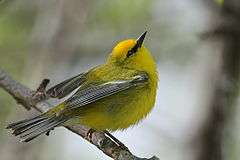
Order: Passeriformes Family: Parulidae
The New World warblers are a group of small, often colourful, passerine birds restricted to the New World. Most are arboreal, but some are terrestrial. Most members of this family are insectivores.
| Common name | Binomial | Status |
|---|---|---|
| Blue-winged warbler | Vermivora pinus | (A) |
| Northern parula | Setophaga americana | (A) |
| Yellow warbler | Setophaga petechia | (A) |
| Yellow-rumped warbler | Setophaga coronata | (A) |
| Blackpoll warbler | Setophaga striata | (A) |
| American redstart | Setophaga ruticilla | (A) |
| Black-and-white warbler | Mniotilta varia | (A) |
| Ovenbird | Seiurus aurocapilla | (A) |
| Northern waterthrush | Parkesia noveboracensis | (A) |
| Common yellowthroat | Geothlypis trichas | (A) |
| Canada warbler | Cardellina canadensis | (A) |
Buntings and New World sparrows
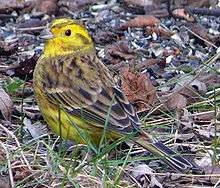
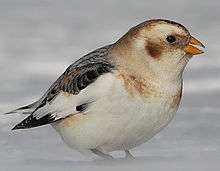
Order: Passeriformes Family: Emberizidae
The emberizids are a large family of passerine birds. They are seed-eating birds with distinctively shaped bills. In Europe, most species are called buntings. In North America, most of the species in this family are known as sparrows, but these birds are not closely related to the Old World sparrows which are in the family Passeridae. Many emberizid species have distinctive head patterns.
| Common name | Binomial | Status |
|---|---|---|
| Yellowhammer | Emberiza citrinella | |
| Pine bunting | Emberiza leucocephalos | (A) |
| Cirl bunting | Emberiza cirlus | (A) |
| Ortolan bunting | Emberiza hortulana | (A) |
| Little bunting | Emberiza pusilla | (A) |
| Rustic bunting | Emberiza rustica | (A) |
| Yellow-breasted bunting | Emberiza aureola | (A) |
| Black-headed bunting | Emberiza melanocephala | (A) |
| Red-headed bunting | Emberiza bruniceps | (Cat.D1) |
| Reed bunting | Emberiza schoeniclus | |
| Corn bunting | Emberiza calandra | (A, formerly bred) |
| Fox sparrow | Passerella iliaca | (A) |
| White-crowned sparrow | Zonotrichia leucophrys | (A) |
| White-throated sparrow | Zonotrichia albicollis | (A) |
| Dark-eyed junco | Junco hyemalis | (A) |
Longspurs and snow buntings
Order: Passeriformes Family: Calcariidae
| Common name | Binomial | Status |
|---|---|---|
| Lapland bunting | Calcarius lapponicus | |
| Snow bunting | Plectrophenax nivalis |
Cardinals and allies
Order: Passeriformes Family: Cardinalidae
The cardinals are a family of robust, seed-eating birds with strong bills. They are typically associated with open woodland. The sexes usually have distinct plumages.
| Common name | Binomial | Status |
|---|---|---|
| Rose-breasted grosbeak | Pheucticus ludovicianus | (A) |
| Indigo bunting | Passerina cyanea | (A) |
| Scarlet tanager | Piranga olivacea | (A) |
Troupials and allies
Order: Passeriformes Family: Icteridae
The icterids are a group of small to medium-sized, often colourful, passerine birds restricted to the New World and include the grackles, New World blackbirds and New World orioles. Most species have black as the predominant plumage colour, often enlivened by yellow, orange or red.
| Common name | Binomial | Status |
|---|---|---|
| Bobolink | Dolichonyx oryzivorus | (A) |
| Baltimore oriole | Icterus galbula | (A) |
Finches

Order: Passeriformes Family: Fringillidae
Finches are seed-eating passerine birds, that are small to moderately large and have a strong beak, usually conical and in some species very large. All have twelve tail feathers and nine primaries. These birds have a bouncing flight with alternating bouts of flapping and gliding on closed wings, and most sing well.
| Common name | Binomial | Status |
|---|---|---|
| Common chaffinch | Fringilla coelebs | |
| Brambling | Fringilla montifringilla | |
| Common rosefinch | Carpodacus erythrinus | (A) |
| Common crossbill | Loxia curvirostra | |
| Two-barred crossbill | Loxia leucoptera | (A) |
| European greenfinch | Chloris chloris | |
| Common redpoll | Acanthis flammea | |
| Arctic redpoll | Acanthis hornemanni | (A) |
| Eurasian siskin | Spinus spinus | |
| American goldfinch | Spinus tristis | (Cat. D1) |
| European goldfinch | Carduelis carduelis | |
| Twite | Linaria flavirostris | |
| Common linnet | Linaria cannabina | |
| European serin | Serinus serinus | (A) |
| Eurasian bullfinch | Pyrrhula pyrrhula | |
| Hawfinch | Coccothraustes coccothraustes | (A) |
Sparrows
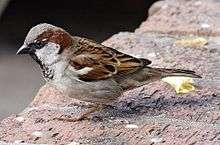
Order: Passeriformes Family: Passeridae
Sparrows are small passerine birds. In general, sparrows tend to be small, plump, brown or grey birds with short tails and short powerful beaks. Sparrows are seed eaters, but they also consume small insects. There are about 35 species worldwide and 2 species which occur in Ireland.
| Common name | Binomial | Status |
|---|---|---|
| House sparrow | Passer domesticus | |
| Eurasian tree sparrow | Passer montanus |
See also
References
- Clements, James F. (2000). Birds of the World: a Checklist. Cornell University Press. p. 880. ISBN 0-934797-16-1.
- Dempsey, Eric & Michael O'Clery (1995) Pocket Guide to the Common Birds of Ireland, Gill & Macmillan Ltd, Dublin.
- Dempsey, Eric & Michael O'Clery (2007) Finding Birds in Ireland: the complete guide, Gill & Macmillan Ltd, Dublin.
- Irish Rare Birds Committee (2007) The Irish List. Accessed 6 April 2009.
- Irish Rare Birds Committee (2009) Irish Rare Bird Report 2007. Accessed 31 October 2009.
- Lepage, Denis. "Checklist of birds of Ireland". Bird Checklists of the World. Avibase. Retrieved 26 April 2007.
External links
| Wikimedia Commons has media related to Aves. |
- National Biodiversity Network Distribution Maps (Ongoing)
- Oiseaux Ireland page. Many photos. Not all species.
- Irish Birding Latest sightings.
- Irish Rare Birds Committee
- NIBWA Northern Ireland Bird watchers Association.
- NIOC Northern Ireland Ornithologists Club. Excellent photographs
- Bird Guides Irish list, county lists, latest sightings and photos.